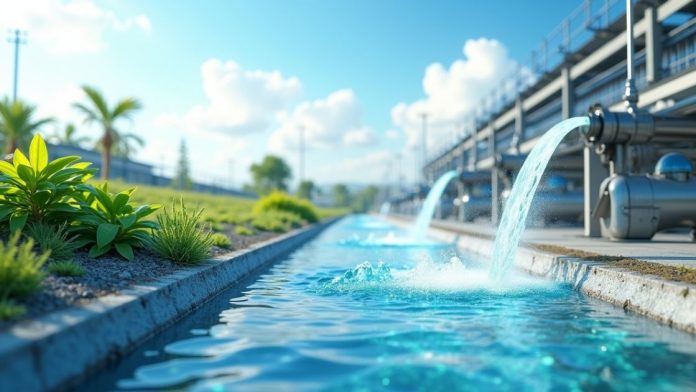Imagine turning something as simple as oxygen into a powerful tool that could purify toxic wastewater. Sounds like science fiction, right? But thanks to ozone wastewater treatment, this is our reality—and it’s revolutionizing how we protect our water.
In an age where water scarcity and pollution are pressing global concerns, the need for smarter, cleaner, and more efficient wastewater treatment methods has never been greater. Enter ozone, a molecule composed of three oxygen atoms (O₃), often known for its role in protecting us from the sun’s UV rays. But on Earth, it’s doing something equally amazing: destroying pollutants with precision and power.
Let’s explore how ozone is helping reshape the future of water management, one molecule at a time.
What is Ozone Wastewater Treatment?
Ozone wastewater treatment is a process that uses ozone gas as a disinfectant and oxidizing agent to purify wastewater. When introduced into contaminated water, ozone reacts quickly and aggressively with organic matter, bacteria, viruses, and even tough industrial pollutants—breaking them down into safer, non-toxic byproducts.
Unlike chlorine and other chemical disinfectants, ozone leaves no harmful residue. It decomposes back into oxygen, making it one of the most environmentally friendly options for water purification.
How Does It Work?
Here’s the breakdown of how ozone gets the job done:
-
Ozone Generation: Ozone is produced on-site using an ozone generator, usually by passing oxygen through a high-voltage electric discharge (corona discharge).
-
Injection into Wastewater: The ozone gas is bubbled or diffused into wastewater using fine-pore diffusers or injectors.
-
Oxidation Process: The ozone molecules oxidize organic contaminants, break down chemical bonds, and kill pathogens within seconds.
-
Byproduct Breakdown: After its work is done, ozone naturally reverts to oxygen, leaving no toxic residuals.
It’s like giving your water a powerful, invisible scrub that leaves it clean, safe, and ready for reuse.
Why Ozone? The Big Benefits
If you’re wondering why more treatment plants and eco-conscious industries are turning to ozone, here are the top reasons:
✅ 1. Superior Disinfection
Ozone is 50% more powerful than chlorine and acts much faster. It kills bacteria, viruses, and protozoa that many traditional treatments miss.
✅ 2. Chemical-Free & Eco-Friendly
No need for transporting or storing hazardous chemicals. Ozone breaks down into oxygen, making it safe for the environment.
✅ 3. Effective on Complex Contaminants
Ozone is excellent for treating pharmaceutical residues, endocrine disruptors, and industrial pollutants that resist conventional treatments.
✅ 4. No Taste or Odor Issues
Unlike chlorine, ozone doesn’t leave any unpleasant taste or smell in treated water, which is a big plus for reuse or discharge.
Real-World Applications of Ozone Wastewater Treatment
Ozone technology is being used across various sectors:
-
Municipal wastewater treatment plants to meet stricter environmental standards.
-
Textile industries to remove dyes and chemicals from wastewater.
-
Food and beverage manufacturing to ensure hygiene and water safety.
-
Hospitals and pharmaceuticals to neutralize antibiotics and medical waste.
In every case, ozone provides a clean, efficient, and scalable solution for tough wastewater challenges.
Actionable Tips for Businesses & Municipalities
If you’re in charge of a water treatment facility, an industrial plant, or simply want to advocate for cleaner solutions, here’s how you can act:
1. Conduct a Water Quality Audit
Understand the specific pollutants in your wastewater and determine if ozone is the right solution.
2. Consult with Ozone Treatment Experts
Work with qualified environmental engineers or service providers to assess, install, and maintain ozone systems tailored to your needs.
3. Integrate with Existing Systems
Ozone can be used as a standalone process or in combination with other treatments (like UV or filtration) for enhanced performance.
4. Promote Sustainability Reports
Highlight your commitment to sustainable water practices through public reports, which is great for brand reputation and compliance.
Frequently Asked Questions
Q1: Is ozone treatment safe for the environment?
Yes, it’s one of the cleanest technologies. Ozone decomposes into oxygen and doesn’t create harmful byproducts like chlorination does.
Q2: How expensive is ozone wastewater treatment?
Initial setup costs can be higher, but long-term savings from reduced chemical use, faster treatment, and water reuse potential make it cost-effective.
Q3: Can ozone be used in small-scale or home systems?
While ozone is mainly used in industrial and municipal applications, some home water purification systems do include ozone for added safety.
Q4: Does ozone work on all pollutants?
It works exceptionally well on organic and microbial contaminants. However, for some heavy metals or specific chemicals, complementary treatments may be needed.
Q5: How long does it take to treat water with ozone?
Ozone acts rapidly—often within seconds to minutes—depending on the contaminant load and system design.
Conclusion
In a world thirsting for clean water and eco-conscious innovation, ozone wastewater treatment shines as a beacon of hope. It’s clean, fast, effective, and born from the very air we breathe.
Whether you’re a policy-maker, business owner, student, or sustainability enthusiast, understanding and advocating for ozone technology is a step toward a healthier, greener tomorrow.
Managing time while diving into important environmental topics can be tough. How do you stay consistent in learning or applying sustainability solutions? Do you have a favorite time management strategy or tool?
👇 Drop your thoughts in the comments. Let’s inspire each other while cleaning up our planet!

